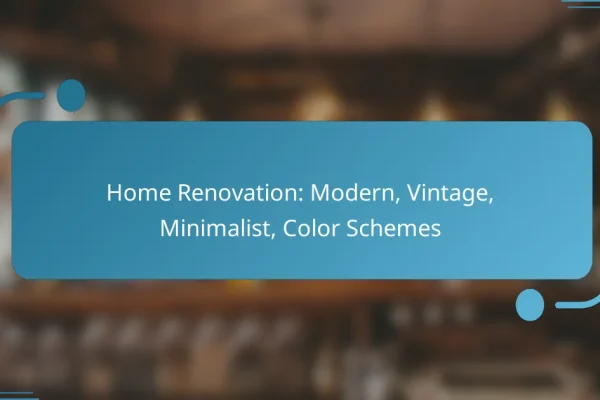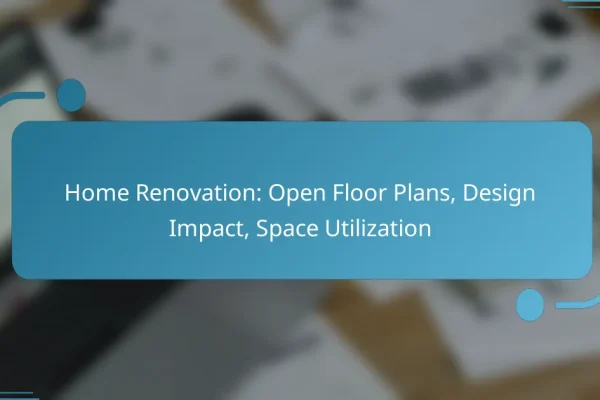What are the current design trends in home renovation?
Current design trends in home renovation focus on creating functional, sustainable, and aesthetically pleasing spaces. Key trends include open floor plans, eco-friendly materials, smart home technology, minimalist aesthetics, and the use of bold colors and patterns.
Open floor plans
Open floor plans continue to be popular as they promote a sense of spaciousness and facilitate social interaction. This design choice often combines the kitchen, dining, and living areas into one cohesive space, making it ideal for families and entertaining guests.
When considering an open floor plan, think about how to maintain distinct zones within the space. Use furniture arrangements, area rugs, or lighting to define different areas without the need for walls.
Eco-friendly materials
Eco-friendly materials are increasingly favored in home renovations due to their sustainability and health benefits. Options include reclaimed wood, bamboo flooring, and low-VOC paints, which minimize environmental impact while enhancing indoor air quality.
When selecting eco-friendly materials, look for certifications like FSC (Forest Stewardship Council) for wood products or ENERGY STAR for appliances. This ensures that your choices contribute positively to the environment.
Smart home technology
Smart home technology is transforming how homeowners interact with their living spaces. Features such as smart thermostats, automated lighting, and security systems can enhance convenience and energy efficiency.
To integrate smart technology, consider starting with a central hub that connects various devices. Ensure compatibility and ease of use, and prioritize systems that offer remote access for added convenience.
Minimalist aesthetics
Minimalist aesthetics emphasize simplicity and functionality, focusing on clean lines and uncluttered spaces. This trend encourages homeowners to choose fewer, high-quality pieces that serve a purpose and contribute to a serene environment.
To achieve a minimalist look, declutter your space and select a neutral color palette. Incorporate natural light and choose furniture with simple designs to enhance the overall aesthetic.
Bold colors and patterns
Bold colors and patterns are making a comeback, adding personality and vibrancy to home interiors. Accent walls, colorful furniture, and patterned textiles can create focal points and express individual style.
When using bold colors, balance them with neutral tones to avoid overwhelming the space. Consider using patterns in smaller doses, such as through throw pillows or artwork, to keep the design cohesive and inviting.
How can I incorporate sustainable design in my renovation?
Incorporating sustainable design in your renovation involves using eco-friendly materials and practices that reduce environmental impact. Focus on energy efficiency, resource conservation, and minimizing waste to create a healthier living space.
Use recycled materials
Using recycled materials in your renovation can significantly reduce waste and lower your carbon footprint. Consider sourcing reclaimed wood for flooring or furniture, recycled glass for countertops, or repurposed bricks for walls.
When selecting recycled materials, check for certifications that ensure quality and sustainability. Local suppliers often carry these materials, which can also support your community’s economy.
Install energy-efficient appliances
Energy-efficient appliances are designed to use less electricity and water, which can lead to lower utility bills and a reduced environmental impact. Look for appliances with the ENERGY STAR label, which indicates they meet strict efficiency guidelines.
Consider replacing old appliances with newer models that offer significant energy savings. For example, modern refrigerators can use up to 40% less energy than those manufactured a decade ago, making them a worthwhile investment.
Choose low-VOC paints
Low-VOC (volatile organic compounds) paints help improve indoor air quality by reducing harmful emissions. These paints are available in a variety of colors and finishes, making them a versatile option for any renovation project.
When selecting low-VOC paints, check the product labels for VOC content. Aim for paints with less than 50 grams per liter for the best results. This choice not only benefits your health but also contributes to a more sustainable environment.
What are popular kitchen renovation trends?
Current kitchen renovation trends focus on functionality, aesthetics, and technology integration. Homeowners are increasingly opting for materials and designs that enhance both the usability and visual appeal of their kitchens.
Quartz countertops
Quartz countertops are a leading choice for modern kitchens due to their durability and low maintenance. Unlike natural stone, quartz is engineered, allowing for a wide variety of colors and patterns that can match any kitchen design.
When selecting quartz, consider thickness and finish. Standard thickness ranges from 2 to 3 cm, with polished finishes being the most popular for their sleek appearance. Be mindful of seams, as larger slabs can minimize visible joints.
Smart kitchen appliances
Smart kitchen appliances are becoming essential in contemporary renovations, offering convenience and efficiency. These devices can be controlled remotely via smartphone apps, allowing for seamless integration into daily routines.
Look for appliances with energy-efficient ratings and features like programmable settings or voice control. Popular options include smart refrigerators that track inventory and ovens that can be preheated remotely. Ensure your home Wi-Fi can support these devices for optimal performance.
Open shelving
Open shelving is a trend that enhances kitchen space by creating an airy feel and making items easily accessible. This design choice encourages homeowners to display attractive dishware and decorative items, adding a personal touch to the kitchen.
When implementing open shelving, consider the materials and placement. Wood and metal are common choices, while shelves should be installed at a height that allows easy access without overcrowding. Regular organization is key to maintaining a clean and appealing look.
What are the latest bathroom design trends?
The latest bathroom design trends focus on creating luxurious, functional spaces that prioritize comfort and aesthetics. Key elements include freestanding tubs, walk-in showers, and natural stone finishes, all of which enhance the overall experience and style of the bathroom.
Freestanding tubs
Freestanding tubs are a popular choice for modern bathrooms, offering a striking centerpiece that combines elegance and relaxation. These tubs come in various shapes and sizes, allowing homeowners to select options that fit their space and style preferences.
When considering a freestanding tub, ensure that there is adequate space around it for accessibility and maintenance. Popular materials include acrylic and cast iron, with prices typically ranging from a few hundred to several thousand dollars, depending on the design and brand.
Walk-in showers
Walk-in showers are increasingly favored for their sleek look and practicality. They often feature glass enclosures and can be customized with various tile designs, making them a versatile option for any bathroom layout.
To maximize the benefits of a walk-in shower, consider incorporating features like built-in benches or multiple showerheads. Installation costs can vary widely, typically falling between a few thousand to over ten thousand dollars, depending on the complexity and materials used.
Natural stone finishes
Natural stone finishes, such as marble, granite, and slate, are trending for their timeless appeal and durability. These materials add a touch of luxury while providing a unique aesthetic that can elevate the entire bathroom design.
When selecting natural stone, consider factors like maintenance requirements and slip resistance, especially in wet areas. Prices for natural stone can range significantly, often starting from around $50 per square foot and increasing based on the type and quality of the stone chosen.
How do I choose a renovation contractor in Los Angeles?
Choosing a renovation contractor in Los Angeles involves careful consideration of their reputation, qualifications, and past work. Start by researching potential contractors to ensure they meet your project needs and budget.
Check online reviews
Online reviews are a valuable resource when selecting a renovation contractor. Websites like Yelp, Google Reviews, and Angie’s List can provide insights into the experiences of previous clients. Look for contractors with consistently positive feedback and a solid overall rating.
Pay attention to the details in reviews, such as communication, timeliness, and quality of work. A contractor with numerous reviews and a high rating is generally a safer choice.
Verify licenses and insurance
Before hiring a contractor, confirm that they hold the necessary licenses and insurance required in California. A valid contractor’s license ensures they are qualified to perform renovation work, while insurance protects you from liability in case of accidents or damages.
You can verify a contractor’s license through the California Contractors State License Board (CSLB) website. Additionally, ask for proof of insurance, including general liability and workers’ compensation coverage.
Ask for project portfolios
Requesting a portfolio of past projects can help you assess a contractor’s style and quality of work. A well-rounded portfolio should showcase a variety of completed renovations, demonstrating their versatility and expertise.
Look for projects similar to yours in scope and style. This will give you a clearer idea of what to expect and help you determine if the contractor’s aesthetic aligns with your vision.
What are the costs associated with home renovations?
The costs associated with home renovations can vary widely based on the scope of the project, materials used, and labor involved. Homeowners should expect to budget for both expected and unexpected expenses, which can range from a few thousand to tens of thousands of dollars.
Average kitchen renovation cost
The average kitchen renovation cost typically falls between $15,000 and $50,000, depending on the extent of the remodel and the quality of materials chosen. A minor update might include new countertops and appliances, while a major overhaul could involve structural changes and custom cabinetry.
When planning a kitchen renovation, consider factors such as layout changes, plumbing, and electrical work, which can significantly impact the overall budget. It’s advisable to set aside an additional 10-20% of your budget for unforeseen expenses that may arise during the project.
To get a clearer picture of costs, homeowners can compare quotes from multiple contractors and review their portfolios. Additionally, researching material prices and exploring budget-friendly options can help keep the renovation within financial limits.







